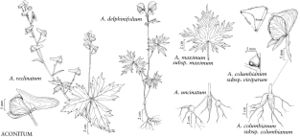Difference between revisions of "Aconitum reclinatum"
Amer. J. Sci. Arts 42: 34. 1842.
FNA>Volume Importer |
FNA>Volume Importer |
||
| Line 13: | Line 13: | ||
}}{{Treatment/ID/Special_status | }}{{Treatment/ID/Special_status | ||
|code=F | |code=F | ||
| − | |label= | + | |label=Illustrated |
}} | }} | ||
|basionyms= | |basionyms= | ||
| Line 40: | Line 40: | ||
-->{{#Taxon: | -->{{#Taxon: | ||
name=Aconitum reclinatum | name=Aconitum reclinatum | ||
| − | |||
|authority=A. Gray | |authority=A. Gray | ||
|rank=species | |rank=species | ||
| Line 54: | Line 53: | ||
|publication title=Amer. J. Sci. Arts | |publication title=Amer. J. Sci. Arts | ||
|publication year=1842 | |publication year=1842 | ||
| − | |special status=Endemic; | + | |special status=Endemic;Illustrated |
| − | |source xml=https://jpend@bitbucket.org/aafc-mbb/fna-data-curation.git/src/ | + | |source xml=https://jpend@bitbucket.org/aafc-mbb/fna-data-curation.git/src/f50eec43f223ca0e34566be0b046453a0960e173/coarse_grained_fna_xml/V3/V3_487.xml |
|genus=Aconitum | |genus=Aconitum | ||
|species=Aconitum reclinatum | |species=Aconitum reclinatum | ||
Revision as of 22:28, 16 December 2019
Roots slender, elongate, fascicled. Stems erect, reclining or climbing, 6-25 dm. Cauline leaves: blade 3-7-divided with more than 4mm leaf tissue between deepest sinus and base of blade, 12-20 cm wide, segment margins cleft and toothed. Inflorescences open racemes or panicles. Flowers white to cream colored, 18-30 mm from tips of pendent sepals to top of hood; pendent sepals 7-10 mm; hood conic to nearly cylindric, 15-23 mm from receptacle to top of hood, 4-12 mm wide from receptacle to beak apex.
Phenology: Flowering late spring–summer (Jun–Sep).
Habitat: Shaded ravines of woods in mountains and upper piedmont
Elevation: to 1700 m
Distribution

N.C., Pa., Va., W.Va.
Discussion
The only American species of Aconitum sect. Lycoctonum de Candolle, A. reclinatum exhibits elongate, fasciculate roots and the tall, conic-cylindric hood characteristic of that section.
Selected References
None.
Lower Taxa
None.
